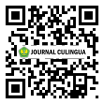THE REFLECTION OF EMBEDDED CULTURE THROUGH THE DIRECTIVE SPEECH ACTS IN THE SOCIAL DILEMMA DOCUMENTARY
DOI:
https://doi.org/10.37301/culingua.v3i3.122Keywords:
cultural values, directive speech acts, the social dilemma documentaryAbstract
In daily life, humans as social beings interact with one another to fulfill their needs. In this case, they tend to use various forms of communication, depending on the purpose. These patterns indicate the culture embraced by the speaker. It is reflected in the values they profess. Related to these phenomena, this study is aimed to analyze the embedded values reflected through the directive speech acts in an American Netflix documentary entitled “The Social Dilemma.” Revealing the negative side of social media, this documentary provides its viewers with the thoughts of technologists, researchers, and also activists with an interest in humanity. Through a descriptive qualitative method, it is found the direct and indirect types of directive speech acts of ordering, forbidding, advising, commanding, and suggesting reflect an embeddedness culture with security and self-discipline as the main values. The results of this study show that the value of security is dominating. These values are indicating the purpose of avoiding children and society from social media addiction.
References
Ariska, E., Yanti, Y. (2022). The Expressive Speech Acts In Kamala Harris` Victory Speech: A Study of Multicultural Values. Journal of Cultura and Culingua, 3(1), 31-38.doi:10.37301/culingua.v3i1.105.
Austin, J. L. (1962). How to Do Things with World. London: Oxford University Press.
Crabtree, M., & Powers, J. (1991). Language Files: Materials for an Introduction to Language and Linguistics (5th ed.). Colombus: The Ohio State University Press.
Creswell, J. W. (1994). Research Design: A Qualitative & Quantitative Approaches. California: Sage Publications.
Cutting, J. (2002). Pragmatics and Discourse. London and New York: Routledge.
Gass, S. M., & Neu, J. (2006). Speech Acts Across Cultures: Challenges to Communication in a Second Language. Berlin: Walter de Gruyter.
Griffiths, P. (2006). An Introduction to English Semantics and Pragmatics. Edinburgh: Edinburgh University Express Ltd.
Oxford Learner`s Pocket Dictionary. (2008). Oxford: Oxford University Press.
Schwartz, S. H. (2013). National Culture as Value Orientations: Consequences of Value Differences and Cultural Distance. Handbook of the Economics of Art and Culture, 547-586. doi:10.1016/B978-0-444-53776-8.00020-9.
Searle, J. R. (1969). Speech Acts. Massachusets: Cambridge University Press.
Searle, J. R. (1976). A Classifications of Illocutionary Acts. Language in Society, 5(1), 1-23. doi:10.1017/s0047404500006837
Seixas, et al. (2017). The Qualitative Descriptive Approach in International Comparative Studies: Using Online Qualitative Surveys. International Journal of Health Policy and Management, 7(9), 778-781. doi:10.15171/ijhpm.2017.142.
Utami, S. T. (2021). An Analysis of the Expressive Speech Acts On World Health Organization Instagram Comments about Covid-19. Unpublished Thesis. Padang: Universitas Bung Hatta.
Utami, S., & Yanti, Y. (2022). Speech Acts of Protest Expressed by Followers of the World Health Organization Instagram Account. KnE Social Sciences, 7(6), 196–206. https://doi.org/10.18502/kss.v7i6.10622
Yanti, Y. (2020). Fungsi Bahasa dalam Tindak Tutur Ekspresif. Iktiar falam Bahasa Festscrift untuk Prof. Dr. Mukhaiyar, M. Pd. Padang: UNP Press.
Yule, G. (1996). Pragmatics. New York: Oxford University Press.
Downloads
Published
Issue
Section
License
Copyright (c) 2022 Elsa Ariska, Yusrita Yanti

This work is licensed under a Creative Commons Attribution 4.0 International License.









